Saving the School

Photo courtesy FAMU College of Law
When Leroy Pernell speaks about becoming dean of the Florida Agricultural and Mechanical University Law School, it’s with a reverence of history and excitement about the future.
“I have been aware of the history of FAMU College of Law for a long time and I’ve always been impressed by their mission, by the importance of re-establishing the school and the historical significance of that,” he says. “When I got a chance to see up close the things the school was trying to do—the interest of the university leadership and the potential of the location in Orlando and what that might mean for a law school—all those things were very intriguing.”
The attractions—its 2002 return to operation after 34 years’ absence, the new (2006) campus in downtown Orlando, and recent recognition by U.S. News & World Report for being the most diverse law school in the nation (tied with Texas Southern University)—were obvious.
But when Pernell accepted the position of dean in 2007, there were also enough big problems at FAMU Law to make one wonder why Pernell didn’t run the other way.
A series of leadership changes, a splintered faculty, the main university being put on probation, low bar passage rates and student lawsuits against the school—not to mention the scandal of a lawyer donating $1 million to finance a law school chair, then taking the position and pay but doing no work—brought FAMU Law vilification in the Florida press and nearly killed it.
ABA site visits in 2005, ’06 and ’07 reported numerous problems and FAMU Law’s failure to adequately address them. Pernell, the dean-designate in the fall of ’07, also faced a deadline: The school had to be turned around by August 2009 to get full accreditation or close.
“We definitely could have failed,” says the university president, James H. Ammons. “And that would have been devastating. The state of Florida needs a vibrant FAMU College of Law to provide diversity. The clock was ticking.”
But by the time an ABA site committee visited again last year, the turnaround was under way; and in late summer the school moved from provisional to full ABA accreditation. In addition to securing accreditation and the U.S. News honor, Pernell has opened a Center for International Law and Justice, one of several “centers of excellence” he plans to open in the next couple years. He has also hired 19 new faculty members and created two new associate dean positions.
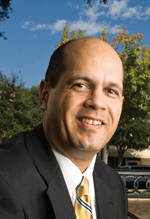
Warren Channell
Photo by Steve Williams
“I think he has accomplished a whole lot,” says Warren Channell, a 2007 graduate of the law school and a lawyer in Winter Garden, Fla. “He put together a team and stayed focused and did what he had to do to get it done. I knew he had a daunting task, but I read up about his background when he came here and I knew he was up to the task.”
Quite a task it was.
BEGINNINGS
What began in 1887 as state normal College for Colored Students became Florida Agricultural and Mechanical College for Negroes in 1909. The historically black school gained university status in 1953.
Its College of Law was originally established in 1949 after a black student was denied admission to the University of Florida law school because of his race. The Florida legislature approved a law school for African-Americans, which opened in the state capital in 1951.
“Ironically,” the ABA site study notes, “it was the relative success of integration and the desire of women to study law that paved the way” for closure of FAMU Law.
The state legislature turned the formerly female campus of the Florida State College for Women into Florida State University, approved a new law school there and took FAMU’s funding to divide it between UF and FSU.
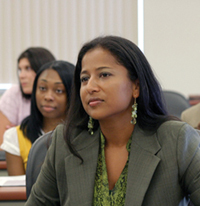
Photo courtesy FAMU College of Law
FAMU Law was prohibited from admitting white students and, in 1966, new students of any race. The last class graduated in 1968.
Over three decades later, FAMU’s attempts to re-establish a law school won state legislative approval. That law also required the school be located not in Tallahassee but between Daytona Beach and Tampa to serve central Florida. The school was also required to serve “historically underrepresented communities,” the ABA report says, to open by 2003 and to win ABA accreditation within five years of opening.
FAMU Law actually beat the first deadline, opening in temporary facilities in August 2002 and getting provisional accreditation in June 2004.
Though the mother school is historically black, FAMU Law is more diverse—just over 40 percent of students are African-American. Full-time tuition for in-state students is $9,036.90 a year, between a bargain and a steal compared to other Florida law schools. The school has also had a higher number of students entering with less-than-stellar undergraduate grades and LSAT scores.
Law school faculty have pointed to the state’s mandates to serve the underrepresented, achieve diversity and admit 750 students as reasons for accepting such applicants. But the academic levels of admitted students and the school’s obligation to “provide the full range of academic support programs to ensure their success” became issues of concern to the ABA site committee.
After a campus visit in January 2005—five months before the first class graduated—a full-team visit was conducted that November. Its report, issued in January 2006, was not good. The ABA Accreditation Committee sent a May 2006 letter listing several areas of concern and noted that FAMU had to develop a plan to bring the law school into full compliance within three years of getting provisional approval and to qualify for full accreditation within five years after that.
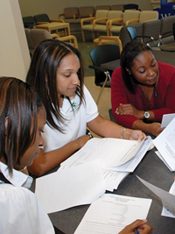
Photo courtesy FAMU College of Law
With the new campus opening in the fall, the clock was indeed ticking.
A SELF-ENDOWED CHAIR
The highest-profile—and the lowest—moment for FAMU Law broke in the news media in June of 2005.
A small group of attorneys had represented 441 Kentuckians suing the manufacturer of the anti-obesity drug known as fen-phen, which was withdrawn from the market after research showed it caused heart-valve problems. According to press reports, a 2001 settlement totaled $200 million. Of that, plaintiffs split $73 million, about $20 million went to a foundation, and the rest went to the lawyers themselves.
One of those Kentucky attorneys, Shirley Cunningham Jr. of Georgetown, donated $1 million to establish an endowed chair at FAMU Law. That donation, according to press reports, won the school a $750,000 matching grant. But there was a catch, the St. Petersburg Times reported: Cunningham himself was to fill the chair and receive a $100,000 salary plus benefits of about $25,000.
By June 2005, dean Percy Luney Jr. was fired after a payroll audit, and Cunningham’s employment ended. Then-interim dean Castell Bryant told the St. Petersburg Times there was no evidence Cunningham had done any work there to earn the salary. Last August, Cunningham was sentenced to 20 years in prison for his part in taking $94 million that should have gone to the fen-phen victims.
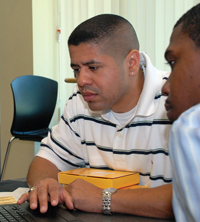
Photo courtesy FAMU College of Law
But that was only one of the problems greeting an ABA site inspection team when it returned to the FAMU campus in late October 2007.
The team met with Ruth Witherspoon, the third interim dean in two years and fourth administrative leader since 2001. The team received a report, called the self-study, that had taken faculty two years to complete. The site team’s report notes “repeated and painful efforts with limited success” to get the faculty to participate in completing the study, even though it was a requirement for full accreditation. The faculty pointed to “lack of time in light of teaching assignments, concentration on scholarly work and service projects, and changes in administration as reasons for their lack of responsiveness,” the site team report says.
Problems the self-study found were also significant:
• Attempting to improve bar passage rates, the faculty took steps that included developing a more stringent grading curve and increasing the attrition rate. Those steps were, the faculty admitted, handled in a “clumsy and ill-conceived manner,” with more than 40 students dismissed, only to have several dismissals reversed.
• Some students filed suit against FAMU Law for failing to follow its own published procedures.
• Little attention, the site commit?tee notes, was given to the need for academic support or the need for faculty to produce scholarly papers.
• “Founding” faculty and younger members were distrustful of each other and at odds.
• Clinical faculty, most of whom were hired for their law firm experience, were teaching doctrinal courses and carrying heavier teaching loads than the ABA recommends.
And FAMU’s difficulties weren’t limited to the law school. In 2005, 41 employees were fired after a state audit revealed that they received more than $1.1 million in annual salaries for doing little or no work. Some were found to be working other jobs while claiming FAMU paychecks; some lived in other states.
In 2008, three FAMU employees were caught tampering with student records in exchange for cash. As many as 90 students paid to have grades changed—often from failing grades to A’s. Others altered their addresses to avoid higher out-of-state tuition.
Frequent leadership changes as well as administrative and deeper financial issues on the main campus led the Commission on Colleges of the Southern Association of Colleges and Schools to put the university on probation in 2007 and keep it there for a full year.
PERNELL STEPS IN
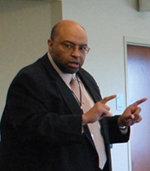
Dean Leroy Parnell
Photo by FAMU College of Law
As dean of the Northern Illinois University law school for more than a decade, LeRoy Pernell was the longest-serving black dean in the country and well-regarded on the national scene. FAMU had reached out to him before, but Pernell hadn’t been ready to leave the DeKalb, Ill., school.
Still, the Brooklyn, N.Y., native had been intrigued by the possibility of leading a young, historically black law school ever since 2003, when he helped conduct a mock site inspection at FAMU during the ABA provisional accreditation process.
Combing over the ABA’s critical report, released in March 2008, the new dean instantly began making changes. No. 1 on the list was attracting new faculty.
“I knew we had to infuse the faculty with new faces, bringing in new as well as experienced law faculty,” he says. Within six months, Pernell had hired 19 new faculty members—several with top-tier academic credentials—and fired two or three others. He revamped the legal writing program, hiring instructors from around the country. And he instituted a bar preparation assistance program.
“He cleaned house,” says Kamilah Jolly, a recent graduate who heads the FAMU College of Law Alumni Alliance and has a solo practice in Orlando. “He did what was necessary. It’s great there is someone there to make people accountable.”
Pernell’s reputation was crucial in attracting new faculty, notes Ammons: “The minute we got him, we got instant credibility in the legal community. He was able to attract some top legal minds.”
Along those same lines, Pernell decided to create the position of associate dean for research and faculty development, a move that is catching on with many universities.

Kamilah Jolly
Photo by Steve Williams
Pernell also realized he would have to handle long-standing faculty disputes by airing the concerns of teachers, staff and students and resolving the matters “transparently and fairly.”
“He seems genuinely interested in what students, faculty and alumni have to say,” Jolly says. “He was willing to sit down and meet with us. That in itself is a difference. We had a very different experience with the past administration.”
At the same time, Pernell made sure he maintained strong ties with his bosses 200 miles away at the school’s main campus in Tallahassee, hitting the road about once a month.
Establishing clinical centers is also important, Pernell says, both in putting the school on the map and reaching out to the community. Largely due to the creation of the Center for International Law and Justice, FAMU became the only historically black college accepted into the International Association of Law Schools.
NEXT CHALLENGE
The U.S. News & World Report ranking, coupled with the school’s September announcement that it had finally received full ABA accreditation, has provided the university with some much-needed good news. And most lay the Orlando law school’s recent successes at the feet of Pernell.
But he is not satisfied. It will take several years before the faculty and writing program are at the level he expects, Pernell says. He is also focused on boosting the school’s bar passage rate. Eighty percent of the 2005 graduates are members of the Florida Bar. In comparison, 94 percent of Pernell’s former students at NIU are members of the Illinois State Bar Association.
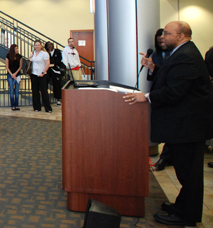
Photo courtesy FAMU College of Law
Part of the equation is improving the quality of students. Some 1,800 applied to the school last year and 630 were accepted. Pernell expects the number of applicants to grow sharply in 2010, enabling the school to be more selective.
Pernell must also contend with the budget crisis that is hitting all Florida public universities and begin concentrating on fundraising. So far, a $3 million endowment has been created.
“We need to create a culture of giving in this community,” he says.
But his biggest challenge lies in maintaining and, indeed, improving the diversity level at the school—something the ABA requires of all law schools. Pernell plans to boost outreach and recruiting efforts to various minority groups.
“We do want to reach out to more diverse people, not just throughout the state of Florida but regionally and nationally, just to get the word out about Florida A&M—that the school was founded in a civil rights tradition,” Pernell says. “I see this as an opportunity to make a national statement … about diversity. We need to prepare students for a diverse world, whether that be gender or ethnicity or age. Students who care about their legal education demand diversity.”
In fact, both Channell and Jolly, the recent FAMU graduates, declared the diversity level at the school valuable, but for different reasons.
Channell picked FAMU not because of its diverse student body but because of geographic convenience. But Channell, who is of mixed Irish and African-American parentage, says being surrounded by diverse students “lends itself to a very lively classroom discussion.”
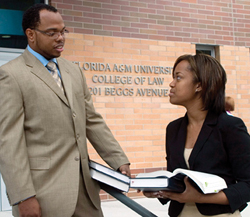
Photo courtesy of FAMU College of Law
“It also lends itself to something a lawyer should have—that is the ability to see an issue from different sides, from your clients’ side and the opposing side and any perspective in between,” he says.
Jolly, who attended the main campus as an undergraduate, researched various law schools’ racial breakdowns before choosing FAMU Law. She specifically wanted a school with a good mix of ethnic groups, rather than one that was predominantly black like Howard or North Carolina Central universities.
“It needs to mirror society and real life,” she says. “I went to school with classmates from the Hawaiian Islands, students who were Jamaican, Hispanic and Asian. The mix was perfect.”
Now that full accreditation is here, “it’s wonderful,” Jolly says, “because a lot of people thought it was something that was not going to happen. A lot of current students were discouraged from coming by members of the community.”
But the accreditation vote does not mean Pernell’s job is over. In some ways, it is just beginning. Explains Darryll Jones, associate dean for faculty research and de?velopment: “The standards the ABA imposes for accreditation are the floor, and we’re reaching for the sky.”
FAMU Law Student Population
| Men | Women | Total | % of Student Body | |
|---|---|---|---|---|
| African-American | 85 | 164 | 249 | 41 |
| Native American | 3 | 2 | 5 | 1 |
| Asian-American | 11 | 11 | 22 | 4 |
| Hispanic | 47 | 54 | 101 | 16 |
| Caucasian | 125 | 98 | 223 | 36 |
| Unknown | 7 | 6 | 13 | 2 |
| Total | 278 | 335 | 613 | 100 |
Source: Florida A&M College of Law
Julie Kay is a freelance journalist in Hollywood, Fla.



